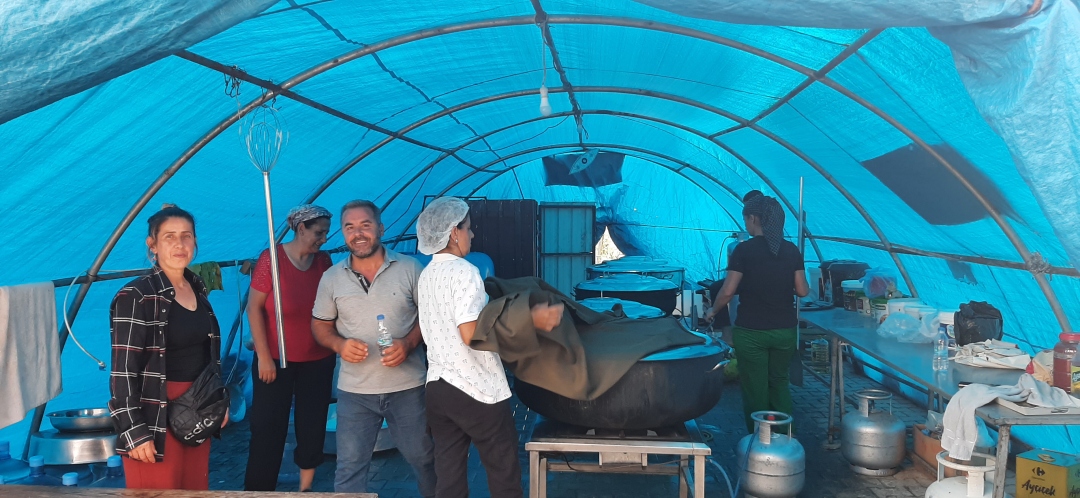Challenge statement
Challenge type: If you are working on multiple challenges, please indicate if this is your "big bet" or "exploratory" challenge.
Please note: we ask you to only submit a maximum of 3 challenges - 1x Big Bet, 2x Exploratory. Each challenge must be submitted individually.
BIG BET
Challenge statement: What is your challenge? (Please answer in specific terms: "Our challenge is that...”.)
Our challenge is to understand the changing needs of the earthquake area, the diversity of vulnerable groups, the motivations for the revitalization of the city and to set an interpretative framework for understanding the mobility motivations of people of Hatay for possible interventions in this region. The field research focuses on mobility dynamics while mapping various vulnerabilities in the earthquake region. Due to the uncertainty, acute changes, and mobility in the earthquake zone, the needs of the region are complex and variable. In this respect, rather than categorizing vulnerable groups such as women, children, and the disabled etc., the study looks at the intersection of needs on this axis.
Such research can shed light on current needs on the axis of mobility, it also provides a meaningful framework for the future of the cities in this region by addressing expectations, discomforts, hopes, and views of the people of the region.
Background: What is the history of your challenge? What is causing or driving it? Who is involved? How does the current situation look like? What undesired effects does it produce?
According to the UN OCHA report based on the data AFAD published on June 1st, following the earthquakes that occurred on February 6, 2023, in Hatay, which had a pre-earthquake population of 2.05 million (as mentioned in AFAD's report dated June 15th, this number was stated as 1,686,043), 23,453 people lost their lives (AFAD, June 15 2023), 30,762 people were injured (UN OCHA, June 1, 2023), 563,751 people left Hatay and went to other provinces, 159,087 people left the provinces they went to, and 404,664 people are currently present in the provinces they went to (AFAD, June 15 2023). The current refugee population in the city was recorded as 350,000 (UN OCHA, June 1 2023).
The research offers the collection of ethnographic storytelling methodologies via qualitative data to compile daily life, and past experiences and determine the motivations of its habitants about the future. Storytelling was chosen as a method because numbers and statistics help us grasp the numerical dimensions of destruction, yet, stories are people-oriented and provide insights into how things are and could be in the future. Whatever the story is told, they describe the unique qualities of different perspectives, strengths, and vulnerabilities.
Quantitative evidence: What (official) data sources do you have on this challenge that better exemplifies the importance and urgency of this frontier challenge? You can add text, a link, or a picture.
In addition to the data provided above, important figures below present the urgency to take action in the earchquake area.
According to data from AFAD dated June 15, 2023, there are 83 completed container cities, 27 with completed infrastructure, 35 with ongoing infrastructure and installation, and 17 planned container cities. The total number of containers installed is 45,604, with 43,027 containers having completed infrastructure. The number of containers required according to the plan is 8,400, and there are 131 livable containers. The total population living in the containers is determined to be 31,056. AFAD carried out the distribution and installation of 229,755 tents, while 30,501 tents were provided by NGOs and institutions. In total, 260,256 tents have been distributed. A total of 130 tent sites, with 12,921 tents and 11,703 individuals living in tents, have been identified. The number of people staying in tent cities is reported as 51,596, with a toilet/shower ratio of 2,988/1,784. Additionally, a total of 3,788 toilets, 2,009 showers, 2,654 washing machines, and 1,452 dryers have been procured. According to the records, currently in Hatay, there are 139 national NGOs, 19 international NGOs, and 31 municipalities. Up until now, it has been documented that a total of 210 national NGOs, 23 international NGOs, 198 municipalities, and 3 special administrations have been active in Hatay. Furthermore, it has been reported by CSOs that there is a current need for 165,000 containers.
According to the United Nations Office for the Coordination of Humanitarian Affairs (UN OCHA) report, updated on June 1st based on AFAD data, 138,000 people who had relocated to other cities have returned. It was determined that 200,000 people are living in tent cities, 64,647 are living in containers, and 900,000 are living in tents or containers they have set up near their own land (these areas are referred to as informal settlements). In addition, there are 158 official tent cities, 260,256 scattered tents across various areas of the city, 88 container cities, 73,000 people living in containers, 3,880 containers used for commercial purposes and 38,000 completed container installations.
In compliance with the field activity reports of the United Nations, assistance was provided to 200,977 households to improve their household living conditions. WASH activities reached 34,848 households, providing hygiene kits to 7,493 families and drinking water support to 6,170 households. Cooked meals were provided to 779,019 individuals through municipal and/or communal kitchens, and cash-based meal support was given to 221,787 individuals. Shelter, mobility, and population figures can be seen on the map at the provincial level.
Qualitative evidence: What weak signals have you recently spotted that characterizes its urgency? Please provide qualitative information that better exemplifies the importance and urgency of this frontier challenge. You can add text, a link, or a picture.
Value proposition: What added value or unique value proposition is your Accelerator Lab bringing to solving this challenge? Why is it your Lab that needs to work on this challenge and not other actors within UNDP, other stakeholders in the country respectively? Why is it worth investing resources to this challenge?
While international and national institutions, organizations and individuals contribute and cooperate in the response and recovery processes of the earthquake region, there is a need for a clear and objective understanding of the locality so that investments and possible interventions can be carried out correctly with local resources, community leaders and a reliable communication network. In order to establish the right connections, it is necessary to create a base for revealing the existing grassroots solutions and learning the actor mapping and spatial qualities. Human qualities and the right way of relating are a necessity within UN CO, as well as for institutions outside of UN during the study, this is a unique "reading the local and mapping the stories" exercise.
Short “tweet” summary: We would like to tweet what you are working on, can you summarize your challenge in a maximum of 280 characters?
AccLab Turkey maps the narratives of the human condition, needs and mobility in the earthquake zone and builds a bridge that explores the local dynamics for possible projects and grassroots solutions.
Learning questions
Learning question: What is your learning question for this challenge? What do you need to know or understand to work on your challenge statement?
Two lines appear in the research:
1. Mapping studies will be made based on the motion/inactivity stories/narratives of people who have never left the city after the earthquake or left the city but returned in a short time in order to continue living in Hatay for various reasons, and needs assessments will be made through the moments/places marked on the maps. These narratives will be associated with the change of solidarity / aid activities stemming from the movement.
2. The memory of belonging to the city, which is thought to be directly related to the cultural heritage of the city, which creates the motivation to continue living in Hatay, and the hopes and expectations of the spatial fiction of daily life, which points out what kind of life is desired in a city, arising from this memory.
In this way, the motivation for the reconstruction and revival of Hatay will be determined together with its needs arising from all the disadvantages; While most of the sections working on cultural heritage and reconstruction are focused on structure/texture, the fact that this research focuses on the space of daily life will provide a different perspective to reconstruction and revitalization activities.
To what stage(s) in the learning cycle does your learning question relate?
Sense, Explore
Usage of methods: Relating to your choice above, how will you use your methods & tools for this learning question? What value do these add in answering your learning question?
The stories will be collected via inclusion into daily life and observation including memory walks in addition to semi-structured interviews, such as focus group interviews. Findings will be supported by audio and visual materials.
In addition, it is foreseen that the learnings and experiences of local NGOs and communities will be reflected in the research, and the interviews with public institutions and organizations will provide input to this field research.
This enables to define types of social profiles and motivations to continue living in this city and how we can cater to their needs while cooperating with them.
In terms of scale and human capacity of the research, it is primarily planned to be conducted in a pilot region, after the completion of the first phase, it can be repeated periodically in different cities with necessary iterations.
Hatay is considered a suitable pilot region because it can offer a rich sample of cases as a city that has heterogeneous social textures, unique cultural contexts, and practices of living together (and UNDP has strong connections in the field). For example, some of the habitants refuse to move to other cities because they believe that their cultural heritage and their daily life practices will be lost if they leave the city. In addition, the insights to be gathered here will make positive contributions to the upcoming projects about the preservation and revitalization of the cultural heritage of the city.
Outputs:
Preliminary assessment report
A spatial case example on mobility - visual map on ArcGIS (via storytelling tool). Suggested entry points for possible intervention regarding recovery process.



 1No poverty
1No poverty 2Zero hunger
2Zero hunger 3Good health and well-being
3Good health and well-being 6Clean water and sanitation
6Clean water and sanitation
Comments
Log in to add a comment or reply.